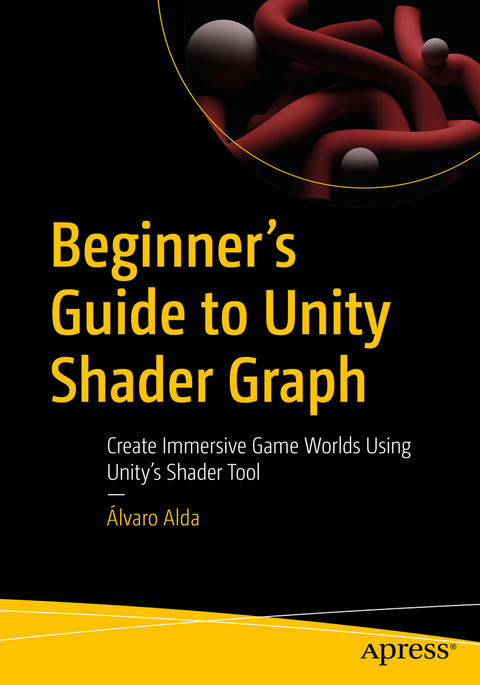
Beginner's Guide to Unity Shader Graph
Apress (Verlag)
978-1-4842-9671-4 (ISBN)
Author Álvaro Alda takes you through each effect step by step, so that you gain a foundational understanding of how they are created using the Shader Graph tool. Practical projects help you put what you're learning into context, from simple effects like 3D scan lines to more complicated effects such as black holes, bubble particles, water, and even interactive snow. Twelve different effects are demonstrated, to cover almost everything related to shader graph.
On completing this book, you will have a thorough understanding of the Shader Graph tool and samples to replicate and continue learning from. Whether you are an indie game developer or technical artist, Beginner's Guide to Unity Shader Graph will give you the confidence to use the Shader Graph tool to create games that will keep players glued to their screens.
What You Will Learn
- Understand the purpose and use of every node and function in Shader Graph
- Gain a working knowledge of the mathematics needed to use the fragment and vertex shaders
- Create complex effects with Shader Graph using post processing and taking full advantage of the URP of the Unity 3D engine
- Develop procedural textures using mathematical nodes in Shader Graph
Who Is This Book For
Technical artists, indie developers, and game developers with little to no knowledge of shaders, but who have basic knowledge of Unity. As the Shader Graph in Unity is similar to other shader editors like Amplify, Blender material nodes and Unreal shaders, this book can be used as reference when working with other platforms and game engines different from Unity.Álvaro Alda is a game developer with over 4 years of experience currently working for Popcore, a pioneer German hypercasual game company. He has also worked at LabCave, a Spanish mobile game company. In his spare time, he likes to work on personal projects, which has led to release of his three games, one of them appearing on national Spanish television. He has also created tools for developers and artists for videogames.
Chapter 0: Unity Set Up and Guidelines
Chapter 1: Introduction to ShadersSub -Topics:-What is a shader?-Vertex and fragment shader-Working spaces (world, object, view, tangent)-Light in URP-Create your first shader in URP
Chapter 2: Shader Graph EditorSub -Topics:-Master nodes Connecting nodes-Properties-Connecting nodes-Subshader
Chapter 3: Noise Sub -Topics:-What is a procedural noise?-Noise samples (Simple, Gradient, Voronoi)-Dissolve effect
Chapter 4: Movement and Time Control Sub -Topics:-Scanlines 3D-UI transition
Chapter 5: SciFi Shaders Sub -Topics:-Hologram effect-SciFi shield
Chapter 6: Scene Depth Sub -Topics:-Water Shader-Acid Shader-Ice refraction-Black hole
Chapter 7: Vertex DeformationSub -Topics:-Bubbles-Snow deformation-Stroke Effects
Chapter 8: PBR MaterialsSub -Topics:-What is PBR?-Lava Effect
Chapter 9: Bonus Effects Sub -Topics:-Retro particles-Interactive Snow-Toon shader
Appendix A: Maths Review Sub -Topics:-Trigonometry-Vector mathematics-Matrix and algebra
Appendix B: Shader Graph NodesSub -Topics:-Coordinate nodes.-Mathematic operation nodes (add, subtract, multiply...)-Restrictive nodes (clamp, frac)-Master nodes (position, base color, normals, smoothness)-Custom functions-Mix nodes (blend, lerp)-Color nodes (color, gradient, etc.)
| Erscheinungsdatum | 20.09.2023 |
|---|---|
| Zusatzinfo | 464 Illustrations, color; 8 Illustrations, black and white; XVIII, 442 p. 472 illus., 464 illus. in color. |
| Verlagsort | Berkley |
| Sprache | englisch |
| Maße | 178 x 254 mm |
| Themenwelt | Informatik ► Software Entwicklung ► Spieleprogrammierung |
| Schlagworte | Procedural Noise • Procedural Shapes • Renderer • Shader Graph • Shaders • Textures • UNITY • URP • Vertex Displacement • Visual Effects |
| ISBN-10 | 1-4842-9671-0 / 1484296710 |
| ISBN-13 | 978-1-4842-9671-4 / 9781484296714 |
| Zustand | Neuware |
| Informationen gemäß Produktsicherheitsverordnung (GPSR) | |
| Haben Sie eine Frage zum Produkt? |
aus dem Bereich


